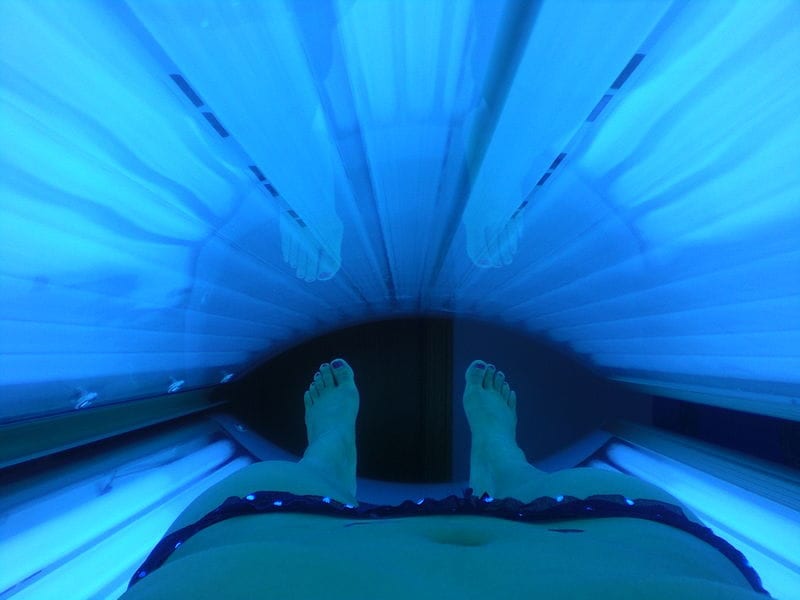Indoor tanning is a term that describes skin tanning achieved through use of equipment such as sun lamps, tanning booths, or tanning beds. Numerous studies have linked this practice to increased risks for developing several form of dangerous or deadly cancer. Despite growing public awareness of these risks, large numbers of people in the United States still continue to use indoor tanning facilities. According to the results of a study published in April 2010 in the American Medical Association’s Archives of Dermatology, significant numbers of people who engage in indoor tanning meet the same criteria used to identify addiction in people who drink alcohol or take drugs. Indoor Tanning Basics All indoor tanning devices produce two forms of ultraviolet light, called UV-A and UV-B, the Centers for Disease Control and Prevention report. Both of these forms of light can damage the cells in the skin and eventually trigger the onset of cancer. Specific types of cancer associated with indoor tanning include a skin cancer called squamous cell carcinoma, another skin cancer called melanoma, and an eye cancer called ocular melanoma. Melanoma of the skin produces more deaths than any other single type of skin cancer. In addition to increasing their cancer risks, people who use UV light to artificially tan their skin increase their risks for wrinkling and other skin changes, as well as their risks for vision damage. Roughly 18 percent of all American women tan themselves with UV light, according to survey information compiled in December 2010 in the Archives of Dermatology. Slightly more than 6 percent of all American men also use indoor tanning facilities. Indoor tanning is especially popular among teenagers; unfortunately, people in this age group also develop unusually high risks for cancer when they expose their skin to UV light. Non-Hispanic, white females between the ages of 18 and 21 tan themselves more frequently than any other population group. Fully 32 percent of all people in this group use an indoor tanning facility; the average user in this group tans herself 28 times a year. Addiction Basics Addiction is a physical and psychological process. Traditionally, doctors and mental health experts use the term to describe the process of addiction to a substance such as alcohol or any one of a number of drugs of abuse. However, the medical community also increasingly employs an addiction model to examine the effects of repetitive behaviors that don’t involve substance use. Physically, addiction produces a reliance or dependency on a substance or activity. When that substance or activity is unavailable, the addict goes through a withdrawal process that has clear physical effects. Physical dependence also produces cravings that make the addict actively seek out a particular substance or activity. Psychologically, addiction produces feelings of pleasure, at least in its initial stages before the addict develops a tolerance to the activity or substance in question. People who seek to recreate these pleasurable feelings will repeatedly try to access the focus of their addiction. Tanning Addiction In the study published in April 2010 in the General Archives of Dermatology, a multi-institution research team examined the mental health and behaviors of 229 college students who used indoor tanning facilities. The researchers concluded that these students tanned themselves an average of 23 times in the 12-month period before the study. Roughly 39 percent of these students qualified as addicts when analyzed with a modified form of a questionnaire normally used to detect drug or alcohol dependency. The study participants were also analyzed with a standard testing procedure that links dependency with the presence of symptoms of depression and anxiety. Roughly 31 percent of the participants qualified as addicts according to the results of this second analysis. Compared to students who don’t use indoor tanning, these students also had higher levels of anxiety and a greater level of participation in marijuana and alcohol use. According to findings reported by the Skin Cancer Foundation, ultraviolet light exposure may present a risk for addiction by increasing the body’s production of endorphins, natural chemicals known to create drug-like effects by reducing pain sensitivity and contributing to an improved sense of comfort or happiness. When the effects of endorphins are artificially blocked in habitual indoor tanning users, they go through withdrawal symptoms—such as jitteriness and nausea—which typically indicate the presence of an addictive process in the body. Importantly, people who don’t tan regularly don’t experience withdrawal when their endorphin responses are blocked. Significance The authors of the April 2010 study in the General Archives of Dermatology believe that many of the people unofficially addicted to indoor tanning may have underlying mental disorders, such as depression or anxiety, that help explain their addictive behavior. They also believe that identification and treatment of these disorders can potentially significantly reduce tanning use in affected individuals, and thereby significantly lower the risks for the eventual onset of some form of potentially fatal skin cancer.

